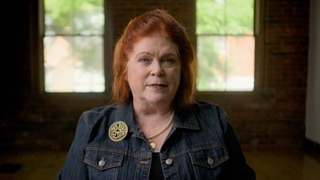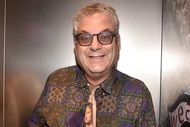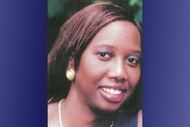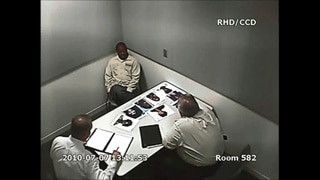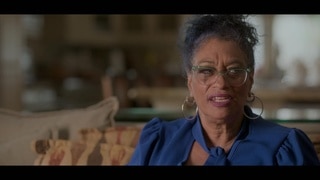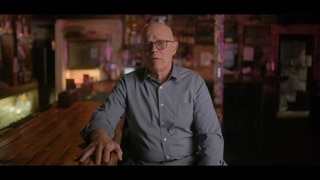Serial Killer Taunted Victims with a Bouncing Ball and Set Off Panic in L.A.: "Depraved"
A witness gave the infamous serial killer his name after observing him bounce a white ball, which caused a frenzy of tips and calls to police.
The Bouncing Ball Killer remains one of California’s most notorious serial murderers, and the identity of the killer is still a mystery to this day. The serial killer, also called the Bouncing Ball Slayer, the Bouncing Ball Strangler, and the Rubber Ball Strangler, terrorized Los Angeles — raping and murdering at least seven women between May 1959 and June 1960.
A witness who claimed to have seen the killer in her apartment told police he was bouncing a rubber ball, giving him his legendary name.
“The killer shuffled out of the bedroom, crouching low, bouncing a rubber ball,” 62-year-old Adela Williams told The Los Angeles Times. “He looked at me. Then, without a word, he calmly walked out the front door, still bouncing the ball, his black hair hanging in a tangle over his eyes.”
Who were his victims? Who were the suspects? Oxygen True Crime takes a closer look at the Bouncing Ball Killer ahead of the new special, Serial Killer Capital: Los Angeles, airing Sunday, Oct. 20.
Who were the victims of the Bouncing Ball Killer?
Ruth Gwinn, 57, was attacked twice in just seven years in Los Angeles — and the second assault killed her. She’s believed to be the first victim of the Bouncing Ball serial killer.
“A sex maniac attacked her early Thursday as she walked at 24th Street and Grand Avenue,” the Associated Press reported on Friday, May 29, 1959. “A shadowy figure leaped out from being a tree and dragged [her] into a parking lot. He beat her with a length of oak flooring, raped her, and abused her with a broken wine bottle.”
In a disturbing twist, the attacker continued the assault, even as neighbors woke.
“The attacker ignored shouted inquiries from nearby apartment residents aroused by Mrs. Gwinn’s screams,” the AP wrote. “Mrs. Gwinn suffered a fractured skull and internal injuries.”
Surviving long enough to tell police what happened, Gwinn died the next day. She was the youngest victim of the Bouncing Ball Killer, and after her brutal murder, the killer seemingly took a long, eight-month break from slaying — until January 1960, when he began a six-month-long reign of terror in Los Angeles.
Los Angeles police pinpoint the next victim of the killer as 73-year-old Amanda Rockefellow. Her body was found strangled in an alley about two blocks from her home on Jan. 29, 1960, The Los Angeles Times reported.
Nurse Ann Cotter, 60, was killed around 6:30 a.m. as she walked to church on Feb. 10, 1960, according to the AP.
Police described the killer as a “depraved strangler who makes weak or elderly women his prey.”
A few months later, 74-year-old Elmyra Miller, a semi-invalid, was killed in her home on May 2, 1960 — her death was linked to the Bouncing Ball Killer, the AP reported. Shortly after, 60-year-old Bessie Elva Green, an apartment house manager, was murdered in her home on May 13, 1960. Then, Grace Moore, 83, was killed in her home on June 20, 1960 — believed to be the oldest victim of the serial killer.
“In 13 months, [police] say, six women have been mistreated sexually, sometimes sadistically tortured, and all but one strangled,” the AP reported.
When 72-year-old Mercedes Langeron became the seventh victim of the Bouncing Ball Killer. After she was strangled in her apartment on June 28, 1960, police got their first break in the case: a witness.
“Her roommate, Mrs. Adela G. Williams, 62, told police the man they believe was the killer was standing in the apartment bouncing a rubber ball when she returned from the store,” the AP wrote. “He fled at her approach.”
At least three other people also saw the killer, and believed they could identify him.
“They saw him, looking calm, bouncing a soft white rubber ball immediately after the latest killing,” the California Eagle reported.
Williams provided a description of the killer: He had on gray Ivy League trousers with a buckle in the back, a light sport shirt, and dark glasses. He was Black, around 30 years old, about 6 feet tall, and weighed about 155 pounds. She also helped police artist Ector Gracia come up with a composite drawing of the suspect.
RELATED: Who Was Rodney Alcala? A Look at the “Unequivocal Carnage” of the Dating Game Killer
What other tips did police get about the Bouncing Ball Killer?
After news of the serial killer got out to the public, other new attacks were reported to police in the summer of 1960 — many involved the lore of the bouncing ball.
A 10-year-old girl and her grandmother were beaten and attacked when an intruder broke into their home on Aug. 18, 1960. 45-year-old Floyd Harris, a boarder of 48-year-old Modie Hall, heard their cries and tried to chase the attacker, but was unable to catch him, the Associated Press reported. But Harris told police “he thought he heard the sound of a bouncing ball when he awakened.”
Another elderly woman pointed the finger at the Bouncing Ball Killer before she died, describing him to police. 84-year-old Lena Bensusen was beaten by a burglar in her home, and later passed away at the hospital on Sept. 6, 1960, the Los Angeles Times reported.
Her death was never officially connected to the serial killer.
RELATED: Everything To Know About The Menendez Brothers’ Murder Trial
Who were the possible suspects in the Bouncing Ball Killer slayings?
After Mercedes Langeron was murdered in June 1960,and a sketch of the killer was released, there was a frenzied search as people panicked over the idea of a serial killer.
“More than 100 citizens have come forward to report that the murderer resembles someone they know, or have seen,” the Los Angeles Mirror reported. “A crew of detectives spent all day Wednesday checking the tips without success.”
But police did make some arrests in those first few months after the sketch.
35-year-old Noble Harper was taken into custody after he was seen bouncing a rubber ball in front of a market on July 2, 1960. But by the next day, he was released, when there was little to no evidence he was involved.
Fears were heightened when 19-year-old Nina Thoeren was raped and strangled with her own capri pants on July 12, 1960 — her body found on the Los Angeles City College campus. Her father was the screen writer of Act of Murder, as well as September Affair and The Prowler.
But 35-year-old Raymond Clemmons confessed to the murder after police found him getting into his car near the murder scene, with Thoeren’s purse on the front seat, the Tucson Daily Citizen reported. He even admitted to joking about being the Bouncing Ball Killer to Thoeren when he convinced her to get in his car for a ride.
“I told her, ‘Sure, I’m the bouncing ball killer,’” the Tucson Daily Citizen reported. “Look in the glove compartment, the ball is in there!”
Despite this, police were never able to prove he was connected to the other murders. He was sentenced to life in prison for Thoeren’s murder, the San Pedro News-Pilot reported.
Shortly after Thoeren’s death, another serial killer suspect was taken into custody, who admitted “all my friends think I look like the Bouncing Ball Murderer,” the California Eagle reported on July 28, 1960. Police were called after 23-year-old Joseph Malveaux was seen near some bushes at the Coliseum, and witnesses feared he resembled the killer.
When asked what he did at night, police said he told them he “wandered around a lot,” and added that he “can’t stand old ladies.”
But police eventually released Malveaux due to a lack of evidence connecting him to the slayings.
One of the most significant arrests came in September 1960, when 28-year-old Henry Busch was arrested for the attempted murder of one of his co-workers, and in the process, confessed to the murder of Elmyra Miller, who was believed to be a victim of the Bouncing Ball Killer, according to the Knoxville News-Sentinel. He also confessed to the murders of two other women, but was never definitively tied to other Bouncing Ball Killer victims.
After the 1960s, the investigation into the Bouncing Ball Killer went cold, and no one has ever been charged in connection with the serial murders.
To learn more about how Los Angeles investigators solved a similar series of slayings in the '90s, watch Serial Killer Capital: Los Angeles on Oxygen Oct. 20.
